Message From Our President

Dear Students, Faculty, Staff and Friends,
I am pleased to present to you this Guide to our plans for the upcoming fall semester and reopening of our campuses. In form and in content, this coming semester will be like no other. We will live differently, work differently and learn differently. But in its very difference rests its enormous power.
The mission of Yeshiva University is to enrich the moral, intellectual and spiritual development of each of our students, empowering them with the knowledge and abilities to become people of impact and leaders of tomorrow. Next year’s studies will be especially instrumental in shaping the course of our students’ lives. Character is formed and developed in times of deep adversity. This is the kind of teachable moment that Yeshiva University was made for. As such, we have developed an educational plan for next year that features a high-quality student experience and prioritizes personal growth during this Coronavirus era. Our students will be able to work through the difficulties, issues and opportunities posed by our COVID-19 era with our stellar rabbis and faculty, as well as their close friends and peers at Yeshiva.
To develop our plans for the fall, we have convened a Scenario Planning Task Force made up of representatives across the major areas of our campus. Their planning has been guided by the latest medical information, government directives, direct input from our rabbis, faculty and students, and best practices from industry and university leaders across the country. I am deeply thankful to our task force members and all who supported them for their tireless work in addressing the myriad details involved in bringing students back to campus and restarting our educational enterprise.
In concert with the recommendations from our task force, I am announcing today that our fall semester will reflect a hybrid model. It will allow many students to return in a careful way by incorporating online and virtual learning with on-campus classroom instruction. It also enables students who prefer to not be on campus to have a rich student experience by continuing their studies online and benefitting from a full range of online student services and extracurricular programs.
In bringing our students back to campus, safety is our first priority. Many aspects of campus life will change for this coming semester. Gatherings will be limited, larger courses will move completely online. Throughout campus everyone will need to adhere to our medical guidelines, including social distancing, wearing facemasks, and our testing and contact tracing policies. Due to our focus on minimizing risk, our undergraduate students will begin the first few weeks of the fall semester online and move onto the campus after the Jewish holidays. This schedule will limit the amount of back and forth travel for our students by concentrating the on-campus component of the fall semester to one consecutive segment.
Throughout our planning, we have used the analogy of a dimmer switch. Reopening our campuses will not be a simple binary, like an on/off light switch, but more like a dimmer in which we have the flexibility to scale backwards and forwards to properly respond as the health situation evolves. It is very possible that some plans could change, depending upon the progression of the virus and/or applicable state and local government guidance.
Before our semester begins, we will provide more updates reflecting our most current guidance. Please check our website, yu.edu/fall2020 for regular updates. We understand that even after reading through this guide, you might have many additional questions, so we will be posting an extensive FAQ section online as well. Additionally, we will also be holding community calls for faculty, students, staff and parents over the next couple of months.
Planning for the future during this moment has certainly been humbling. This Coronavirus has reminded us time and time again of the lessons from our Jewish tradition that we are not in full control of our circumstances. But our tradition also teaches us that we are in control of our response to our circumstances. Next semester will present significant challenges and changes. There will be some compromises and minor inconveniences--not every issue has a perfect solution. But faith and fortitude, mutual cooperation and resilience are essential life lessons that are accentuated during this period. And if we all commit to respond with graciousness, kindness, and love, we can transform new campus realities into profound life lessons for our future.
Deeply rooted in our Jewish values and forward focused in preparing for the careers and competencies of the future, we journey together with you, our Yeshiva University community, through these uncharted waters. Next year will be a formative year in the lives of our students, and together we will rise to the moment so that our students will emerge stronger and better prepared to be leaders of the world of tomorrow.
Best Wishes,
Ari Berman

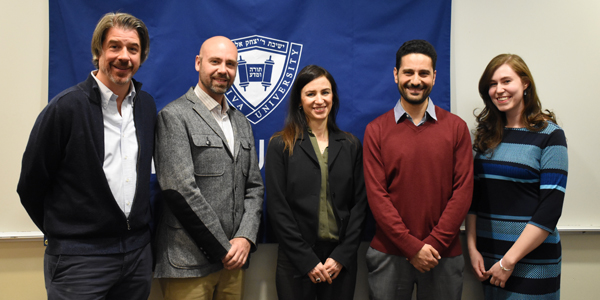 (l-r): Louis Bickford, Douglas Burgess, Vere Békés, Faraz Sanei and Meirah Shedlo (academic advisor & special projects manager at Yeshiva University and organizer/moderator of the panel discussion)
(l-r): Louis Bickford, Douglas Burgess, Vere Békés, Faraz Sanei and Meirah Shedlo (academic advisor & special projects manager at Yeshiva University and organizer/moderator of the panel discussion)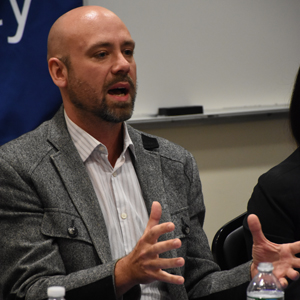 For instance, as Dr. Burgess noted, “a trial is blunt and can’t really get at the full truth” because a trial works by starting with a blank canvas upon which is reconstructed the crime. “The danger is,” added Dr. Burgess, “is that no crime will emerge,” even if a great wrong has been done. And in trials dealing with genocide, such as with the Nuremberg trials after World War II, it can difficult, if impossible, to separate the defendants from their symbolism, which complicates issues of punishment and restitution.
For instance, as Dr. Burgess noted, “a trial is blunt and can’t really get at the full truth” because a trial works by starting with a blank canvas upon which is reconstructed the crime. “The danger is,” added Dr. Burgess, “is that no crime will emerge,” even if a great wrong has been done. And in trials dealing with genocide, such as with the Nuremberg trials after World War II, it can difficult, if impossible, to separate the defendants from their symbolism, which complicates issues of punishment and restitution.
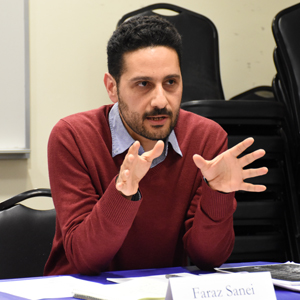 Truth and reconciliation commissions, such as those established in South Africa in 1995 and Rwanda in 1999, aim to do exactly what the name suggests: tell the truth to promote reconciliation between the people who had suffered butchery and the people who had butchered them.
But as Sanei pointed out, while the commissions can unleash “the powerful effects of truth,” they cannot always deliver justice. For instance, in Rwanda, while the special courts set up for the commission heard an estimated 1.9 million public cases, the process, inevitably overwhelmed by the caseload, came up short on the vital question of reparations for victims, and many of the defendants demanded immunity for their truthfulness, meaning that, over time, the perpetrators, unpunished, went to live among those they had brutalized. A Human Rights report published in 2011 concluded that while the commission “may have served as a first step. . . it did not manage to dispel distrust between many perpetrators and survivors.”
Truth and reconciliation commissions, such as those established in South Africa in 1995 and Rwanda in 1999, aim to do exactly what the name suggests: tell the truth to promote reconciliation between the people who had suffered butchery and the people who had butchered them.
But as Sanei pointed out, while the commissions can unleash “the powerful effects of truth,” they cannot always deliver justice. For instance, in Rwanda, while the special courts set up for the commission heard an estimated 1.9 million public cases, the process, inevitably overwhelmed by the caseload, came up short on the vital question of reparations for victims, and many of the defendants demanded immunity for their truthfulness, meaning that, over time, the perpetrators, unpunished, went to live among those they had brutalized. A Human Rights report published in 2011 concluded that while the commission “may have served as a first step. . . it did not manage to dispel distrust between many perpetrators and survivors.”
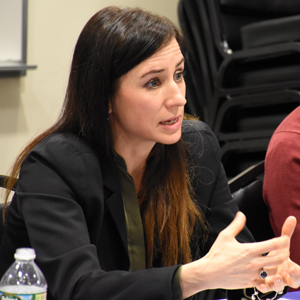 But because these efforts do not produce the expected results, noted Dr. Békés, does not mean that they don’t have value for the individuals and communities involved in the process. “Very important things happen here, as my work has showed me,” she pointed out. The processes help to establish a narrative, an accepted script for what did and did not happen, told in voices that, up to that point, had been considered marginal or worthless. On a personal level, she continued, “the chance to tell a story, even if that story doesn't go any farther than the person telling it, is a powerful move towards personal healing”: being acknowledged can restore one’s emotional and spiritual health.
“There are also the benefits of archiving, of memorializing, of the reconstructions of normality,” she added, “all of which are forms of acknowledgement crucial to getting past the trauma and invisibility.”
But because these efforts do not produce the expected results, noted Dr. Békés, does not mean that they don’t have value for the individuals and communities involved in the process. “Very important things happen here, as my work has showed me,” she pointed out. The processes help to establish a narrative, an accepted script for what did and did not happen, told in voices that, up to that point, had been considered marginal or worthless. On a personal level, she continued, “the chance to tell a story, even if that story doesn't go any farther than the person telling it, is a powerful move towards personal healing”: being acknowledged can restore one’s emotional and spiritual health.
“There are also the benefits of archiving, of memorializing, of the reconstructions of normality,” she added, “all of which are forms of acknowledgement crucial to getting past the trauma and invisibility.”
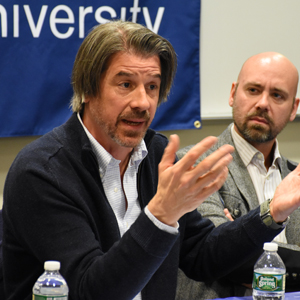 If the usual memorials are written by the victors, said Bickford, “then these kinds of efforts to bring out the truth is a way of saying, ‘Maybe they don't always get to write the story.’” He noted the recent efforts by New York City to erect more statues of women in the city’s parks and the New York Times to publish obituaries of those who did not make the cut back in a white-male-dominated era, which has meant more women, more people of color, more ordinary people. “Liberation movements,” he added, “can fight on this enlarged terrain, using a fuller history that’s not so curated. ‘Knowledge’ doesn’t always lead to ‘acknowledgement,’ but these new histories make that more possible.”
All agreed that making that “fuller history” possible requires a shift in cultural attitudes and behaviors that is, as Sanei understated it, “a tall order.” Perhaps religious leaders can do it, or religious leaders in league with political leaders who want to institute a proper program of memorializing, or all of that in concert with a "citizenship education” campaign. None of the panelists could say with any certainty how that shift happens, only that anything like transitional or restorative justice will happen only when that shift takes place.
In a brisk Q&A session after the formal presentation, students raised many insightful questions: Can the focus be placed on victims without involving the perpetrators? Is it better to whitewash a history or deny it? How does a genocide begin? The panelists had equally sharp answers: Some memory is better than none. Silence can’t provoke a discussion, and without the discussion, nothing can get done. “That happened in the past” is often a dodge to avoid naming names.
If the usual memorials are written by the victors, said Bickford, “then these kinds of efforts to bring out the truth is a way of saying, ‘Maybe they don't always get to write the story.’” He noted the recent efforts by New York City to erect more statues of women in the city’s parks and the New York Times to publish obituaries of those who did not make the cut back in a white-male-dominated era, which has meant more women, more people of color, more ordinary people. “Liberation movements,” he added, “can fight on this enlarged terrain, using a fuller history that’s not so curated. ‘Knowledge’ doesn’t always lead to ‘acknowledgement,’ but these new histories make that more possible.”
All agreed that making that “fuller history” possible requires a shift in cultural attitudes and behaviors that is, as Sanei understated it, “a tall order.” Perhaps religious leaders can do it, or religious leaders in league with political leaders who want to institute a proper program of memorializing, or all of that in concert with a "citizenship education” campaign. None of the panelists could say with any certainty how that shift happens, only that anything like transitional or restorative justice will happen only when that shift takes place.
In a brisk Q&A session after the formal presentation, students raised many insightful questions: Can the focus be placed on victims without involving the perpetrators? Is it better to whitewash a history or deny it? How does a genocide begin? The panelists had equally sharp answers: Some memory is better than none. Silence can’t provoke a discussion, and without the discussion, nothing can get done. “That happened in the past” is often a dodge to avoid naming names.
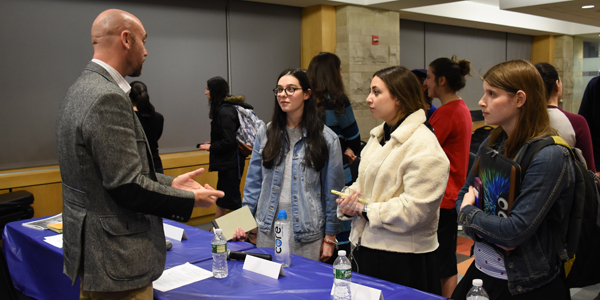 Q&A with the panelists
Q&A with the panelists